Spam filtering is becoming more rigorous. Because spam filters are regularly changing to keep up with new technologies and types of spam messages, what can be delivered to the email inbox today might be spam tomorrow.
According to Statista, spam messages made up 48.16% of global email traffic in March 2018.
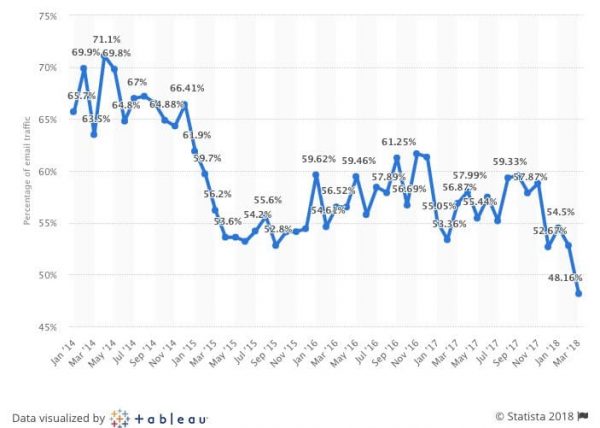
Therefore, spam emails have become a critical problem that marketers should never underestimate as they affect the sender’s reputation as well as email deliverability.
Below are all possible reasons that cause emails to land in your recipients spam folder and how to maximize your email deliverability.
- Didn’t conform to the CAN-SPAM rules
- Your IP address might have been used by someone else for spam
- Low Open Rates
- Double opt-in is missing
- Emails are exceedingly reported as spam by subscribers
- Low mailbox usage
- Misleading subject lines
- Company’s physical address is not included
- Unsubscribe link is missing
- Your email spam score is high
- Text-to-image ratio is low
- Using mysterious font styles
- Emails are not optimized for mobile
- High frequency of sent emails
- Using a paid mailing list
- Not sticking to the SPF and DKIM Validation Systems
- Provide a preference center
- Send valuable content
- Review your email engagement metrics
- Stick to one sender inbox
- Warmup your IP address
- Swap your IP
- Use chunk sending
- Create a sunset policy
1. Didn’t conform to the CAN-SPAM rules
Instead of making the opt-in a required option for their subscribers, email marketers collect emails of business cards from conferences and skip this option. This violates the CAN-SPAM compliance rules. Violating the CAN-SPAM act may lead to penalties of up to $16,000.
Make sure you comply with the rules and understand the CAN-SPAM act of each country.
2. Your IP address might have been used by someone else for spam
If your IP address is used by someone else for spam, your email will be flagged as spam even if you don’t send spam yourself.
Use a reliable email service provider that has strict rules and regulations on IP protection.
3. Low open rates
Webmail providers highly value the importance of an email being opened and take into consideration those that have been either rejected or deleted by recipients as a major factor in spam filtering decisions. As a result, if the open rate is low, the chance for emails to be flagged as spam increases. Here’s a table that includes benchmarks of the unique email open rate by industry (%):

Source: IBM
To boost your open rates, create different segments, use compelling subject lines and send your emails at the appropriate times.
We also interviewed Colin Sharpe from SendGrid, and he gave us his input regarding what the average open rate for a marketing industry should be, the recent updates in email marketing and what you must know as an email marketing expert.
If you want to learn more, watch this video below:
4. Double opt-in is missing
One of the biggest mistakes some marketers may ignore is requiring a double opt-in; in this case, any person could enter any email address to sign-up any other person.
Offer your subscribers the option to opt-in twice. The first time when they subscribe to your newsletter and the second when they receive a welcome, confirmation email, asking to verify their email address. Confirming their subscription shows that they are interested in receiving emails from you which increases the chance for email engagement and reduces spam.

5. Emails are exceedingly reported as spam by subscribers
Another factor mailbox providers look at is spam complaints. When emails are frequently reported as spam, the chance of future campaigns being delivered to the spam folder increases. Your contacts might report your email because they find it misleading or they don’t remember your business as it may not have proper branding.
Use a tone of voice that reflects your brand. Include your company’s name in the “from name” and/or email signature and put the “unsubscribe” option so they can opt-out if they no longer want to receive emails from you. The “from name” should always include your name, company name, one of your team’s names or a combination of both; for example “Eddy from Emark Solutions”. Don’t change it frequently, rather, keep it memorable for your subscribers.
6. Engagement is low
Mailbox providers check email accounts that are inactive on your list. If you have a large number of email addresses on your list and the majority of them are dormant, it will be considered as a red flag for spam filters.
Check your subscribers who have not engaged with your emails for a while. Although those who don’t want to receive emails from you may unsubscribe, a large part might simply ignore this. As a result, sending an email asking them to unsubscribe is a great option to minimize spam filters recognizing inactive email accounts.
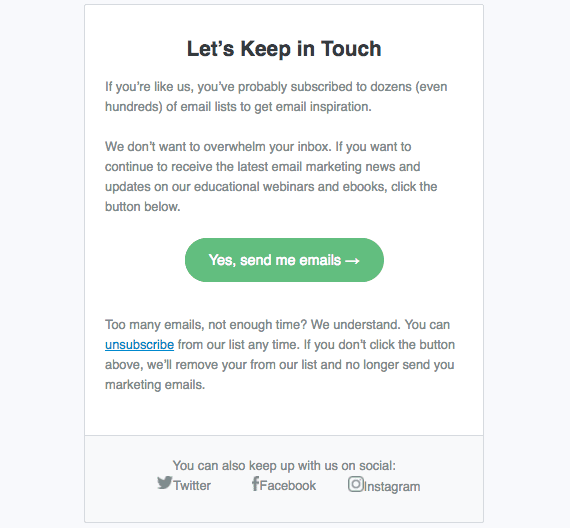
Having a small list of engaged email addresses is much better than having a large list of inactive users.
In addition, we’re in the age of engagement email marketing. ESP’s care more about the experience of their users than the marketer. With that in mind, they are introducing more options to prioritize inbox views based on interactions. Google Gmail app for example, has added many features around that. They now ask you to unsubscribe from bulk senders you haven’t interacted with and build reputation profiles around this qualification.
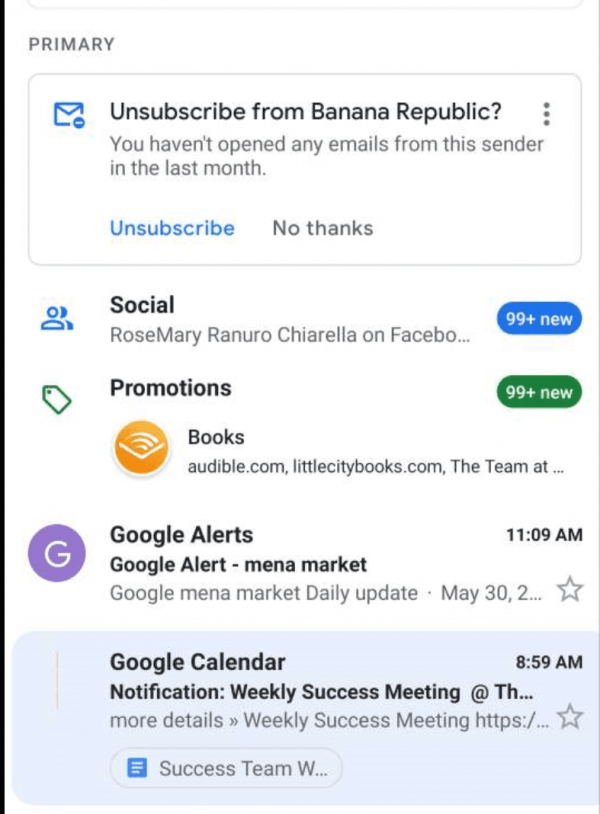
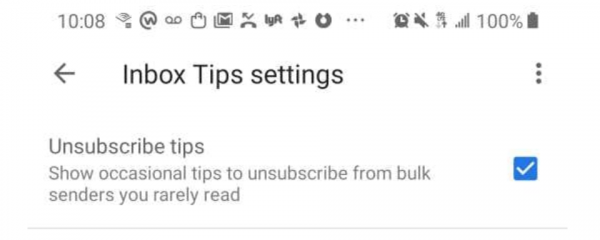
Be proactive on segmenting your lists between those who engage with your content (open or click through) and those who do not.
7. Misleading subject lines
According to the CAN-SPAM act, it’s against the law to intentionally push someone to open a subject line that includes deceiving triggers. Using subject lines that are not relevant to your email content leads your subscribers to report your email as spam.
Avoid these gray areas. For example, never include words like “urgent” or “free” if your email doesn’t have an urgent argument or free offer.
8. Company’s physical address is not included
Not mentioning your company address violates the CAN-SPAM act and increases the chance of your emails being flagged.
Include your street address, a post office box that has been registered with the U.S. Postal Service, or a private mailbox registered with a commercial mail receiving agency established under postal service regulations.
9. Unsubscribe link is missing
One of the major reasons your emails may be reported as spam is the absence of an unsubscribe option. Even if you have the best emails on earth, you can’t risk being hit by penalty fees of thousands of dollars.
Ensure you include unsubscribe links at the footer of your emails. If some of your contacts click to unsubscribe, you should respect their choice. You can ask them to fill out a survey of why they no longer wish to receive emails from your company to find out how to prevent future opt-outs. You might also send them an email to re-subscribe in case the step they previously took was a mistake.
10. Your email spam score is high
There are spam trigger words that are recognizable by filters when used in the subject line or email body which increase the likelihood for spam filters to catch your emails and prevent them from being delivered to your subscribers inbox.
Avoid every phrase or keyword that boosts your email spam score. Use keywords that are relevant and emphasize what your subscribers will get from your email. You can use a marketing automation tool that allows you to detect your spam score and determine how to reduce it.
11. Text-to-image ratio is low
Using too many images vs text can raise red flags for spam filters. This has been formulated because spammers used to mislead mailbox providers by including information in images instead of text so the filters could not read the content.
If you want to use images, make sure your text to image ratio is 60/40 which means that your emails should be 60% text and 40% image.
12. Using mysterious font styles
Writing emails in obscure font styles that are not familiar across platforms may increase the chance of your emails being flagged as spam.
Use font styles such as Arial, Verdana, Georgia, Times New Roman, Trebuchet or Geneva.
13. Emails are not optimized for mobile
If your emails are not responsive across email clients and devices, your emails will skip the inbox and go immediately to the spam folder.
Ensure that your emails are optimized across all email clients and browsers. You can use a marketing automation platform that allows you to preview your emails before sending them out to your subscribers.
14. High frequency of sent emails
Sending out emails too frequently throughout the day, month or week increases the probability of mailbox providers to flag your emails as spam (even if you try to send the same email and content using a different email address). According to Chadwick Martin Bailey, 69% of U.S. email users unsubscribe from a business or non-profit email because the organization sends too many emails.
Although there’s not a dictated rule of how many emails you should send, find your own sweet spot while avoid sending excessive emails.
15. Using a paid mailing list
This strategy is doomed to fail in all angles. The majority of owners of these purchased email accounts don’t know about your business which therefore, leads them to report your emails. Another scenario is that some of these accounts may be no longer active which raises the red flag for spam filters.
It’s always advisable to build your email list organically. Build your list by generating leads using popups, opt-in forms or landing pages.
16. Not sticking to the SPF and DKIM validation systems
If you don’t have these authentication and validation systems for your business email, you will be at risk. Mailbox providers may reject your emails and move them to filters to determine whether it should be delivered or not.
In order for mailbox providers to confirm the identity of the sender, authenticate your IP address with SPF and DKIM records. These verify your identity and shows your legitimacy in sending emails. Google and Yahoo love authenticity and are more likely to deliver a mail from an authenticated email address to your recipients inbox.
Here’s how each one works:
- Sender Policy Framework “SPF”: Proves your identity by comparing your IP (found in the domain’s DNS record) with a list of IPs authorized to send from that domain.
- Domain Keys Identified Mail: Meeting this standard ensures your email was not hit by any unauthorized alterations during transmission.

Additional tips to maximize your email deliverability
17. Provide a preference center
Asking your subscribers how frequently they wish to receive emails from you reduces the potential of your emails being marked as spam and boosts your engagement rate. In addition, if you have a subscriber opting in to more than one list, you can ask him to update his preferences and choose which email lists he wants to keep subscribed to or opt out to avoid him unsubscribing from all your lists at once.
18. Send valuable content
Whenever you send an email of value, you’re likely to boost the potential for higher engagement (CTR) and lower spam complaints. Make sure you always provide fresh and educational information.

19. Review your email engagement metrics
Analyze your email marketing performance to identify what needs to be improved or reconsidered. Keep an eye on your open and click through rates and spam complaints.
If you notice that your email open rate is decreasing, review your subject lines and email frequency as these two mainly affect this metric.

20. Stick to one sender inbox
ESPs started to look at the reputation of an inbox, not only domain reputation. With that in mind, send from a real person versus a generic email (ex: jimmy@yourdomain.com) and continue sending from that inbox. You can always dedicate one inbox for marketing purposes and one email for transactional communications. You can also take it to another level and separate the sending to different sub-domains and isolate the reputation of your marketing pool from your transactional pool.
ESPs are getting stricter when it comes to the type of content that are being sent. Sometimes you can be a legitimate sender and have a false positive. In the example below, a legitimate invoice from Paypal was sent to spam with a big warning at the top.
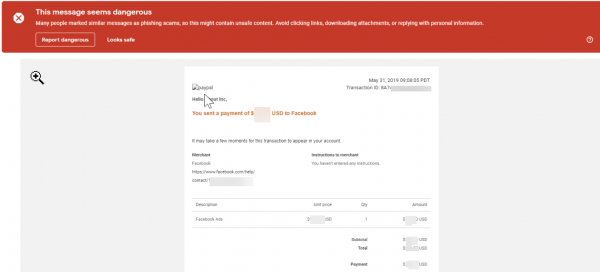
Choose your content carefully and avoid including negative keywords in your subject line and body.
21. Warmup your IP address
If you have a new IP address and have not used it yet to send emails, warm it up gradually by sending to small data sets in the first stage.
For instance, let’s say you want to warm up your IP address and you have to send 100,000 emails. If you send an email to all your contacts at once, the server might classify the email as spam or reject it completely. Instead, break it down into 10 groups, each one having 10,000 contacts and send an email everyday to the first 10,000 contacts during the first week. For the second week, add another 10,000 contacts and repeat the same procedure and so on. If you notice at the end that the bounce rate exceeds 10% and complaint rate is greater than 0.1%, reduce your sending volume to 5,000 messages/day. To help reduce your bounce rate, here’s a list of email bounce codes that you may find useful.
To get a further idea on warming up your IP address, here’s a great article by Sparkpost and another by Sendgrid.
22. Swap your IP
This works well if you have more then 2 IPs in your sending pool, preferably 4, whereas if one IP gets blacklisted by spam filters, you can remove it temporarily from the pool and apply for delisting from the respective spam trap authority. This way, your sending is not impacted by that one IP.
23. Use chunk sending
Chunk sending is a great method to break down your target lists into smaller sub-sets so you can mitigate your sending risk (spam, bounces etc…) across a longer period of times, giving you more flexibility to monitor the performance of your campaign and pause/resume as you see fit. This feedback loop can help you improve and provide a self managed warmup procedure for your sending domains and inboxes. As an example, you can break down a list of 20K contacts, into smaller batches of 500 emails per hour, between 8am and 5pm, from Monday through Friday. The campaign will then execute accordingly until the full 20K has been completed. You have the flexibility to apply chunk sending into your campaigns using VBOUT from your campaign manager.
24. Create a sunset policy
You have to be proactive in how you segment and target your lists. Those who are more engaged with your content (opens and CTR) should be in their own lists, versus those that are not opening your emails (example 3 months of inactivity). Sending to an engaged list of contacts will increase your engagement rate with ESP’s and in turn improve your reputation. You can create reactivation campaigns and automation, targeting strictly your cold lists from a different sending domain, then the one from your active domain to try and move people into an active status. At VBOUT, we are creating an automated smart sending and sunset policy that you can configure to do this work for you.
Although it takes hard work to create and send winning email campaigns, nothing is impossible, especially when you understand the elements that have a negative impact on your emails and avoid them as much as you can.
Want to boost the effectiveness of your email marketing strategy? Book a demo with our success managers.
Don’t forget to share this article


